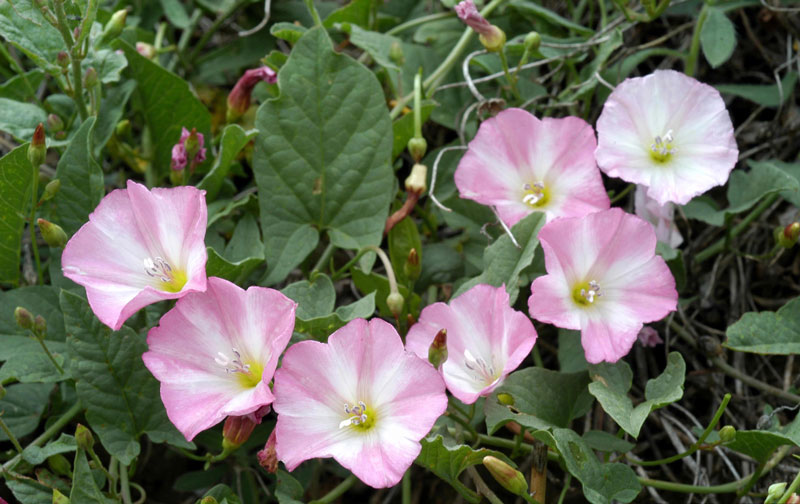Field Bindweed
Convolvulus arvensis
Description
Field bindweed is a perennial vine (0.4 – 2 inches in height) arising from deep, persistent, spreading roots. It has slender, trailing to somewhat twining, branched stems, 8 to 79 inches long (source). Mature field bindweed plants have arrowhead-shaped leaves that can be 1/2 to 2 inches long. The flowers are trumpet shaped, white to pink, and 1 to 1 1/2 inches wide. Field bindweed is a prostrate plant unless it climbs on an object for support. The root system has both deep vertical and shallow horizontal lateral roots. The vertical roots can reach depths of 20 feet or more (source).
Habitat
Field bindweed is found in a wide range of habitats: roadsides, stream banks, lake shores, ditches and croplands. This species prefers strong sunlight and moderate-to-low moisture. It does not grow in wet soils (source).
Location in Nebraska
A listed county noxious weed in Banner, Box Butte, Cheyenne, Deuel, Garden, Morrill, Scotts Bluff, and Sheridan counties in Nebraska.
Pathway of Introduction and Spread
Originally from Europe and Eurasia, field bindweed was first detected in the United States as early as 1739 in Virginia. It is thought to have come to the United States in contaminated crop seed and has developed into a highly invasive species that is very difficult to control. It has been used as an ornamental plant and as a ground cover. Making it even more difficult to control is the fact that it reproduces by both seeds and rhizomes (source).
Impacts
Field bindweed is one of the most persistent and difficult-to-control weeds in landscapes and agricultural crops. It has a vigorous root and rhizome system. Field bindweed also is very drought tolerant and once established is difficult to control even with herbicides. It can devalue land and the field bindweed precludes planting of many vegetable crops (source).
Management
Field bindweed is difficult to eradicate because the seeds remain viable in soil for up to 20 years. One plant can produce up to 500 seeds. Mechanical controls include: discing, tilling or hand pulling. Chemical controls include: Application of herbicide 2,4-D or glyphosate; applications that trans-locate to roots, before seeds set. Research suggests that shading will help control this species; mulching using paper, straw, wood chips, or black plastic can be effective in certain areas (source). Biological control includes the use of one or two insects. The field bindweed moth (Tyta luctuosa is a moth in the family Noctuidae) was first introduced in the U.S. in 1987 in Arizona, Iowa, Missouri, Oklahoma and Texas. The majority of the damage to field bindweed comes from the larval stages of T. luctuosa feeding on the leaves and flowers. of the plant. The bindweed gall mite (Aceria malherbae) is also a biological control for field bindweed. A. malherbae can begin to control the population of the field bindweed by reducing flower and seed production. Stunting of plant growth may be seen within weeks of mite introduction. Mowing of infested bindweed is recommended since it helps spread the mites. Learn more here.
Rootsystem image: Redrawn from B. F. Kiltz. 1930. J. Amer. Soc. Agron. 22:216-234
Norman E. Rees, USDA Agricultural Research Service – Retired, Bugwood.org
USDA Agricultural Research Service, Bugwood.org
Howard F. Schwartz, Colorado State University, Bugwood.org
K. George Beck and James Sebastian, Colorado State University, Bugwood.org
Whitney Cranshaw, Colorado State University, Bugwood.org
Eric Coombs, Oregon Department of Agriculture, Bugwood.org
Bruce Ackley, The Ohio State University, Bugwood.org







